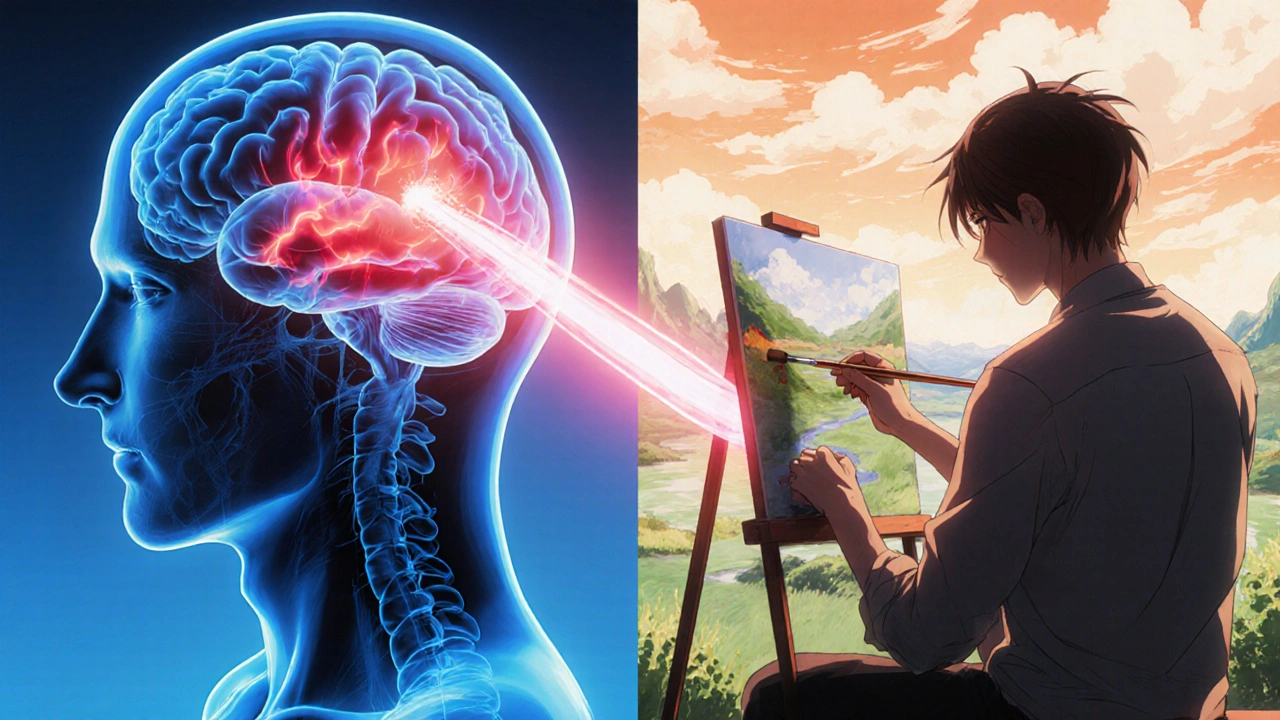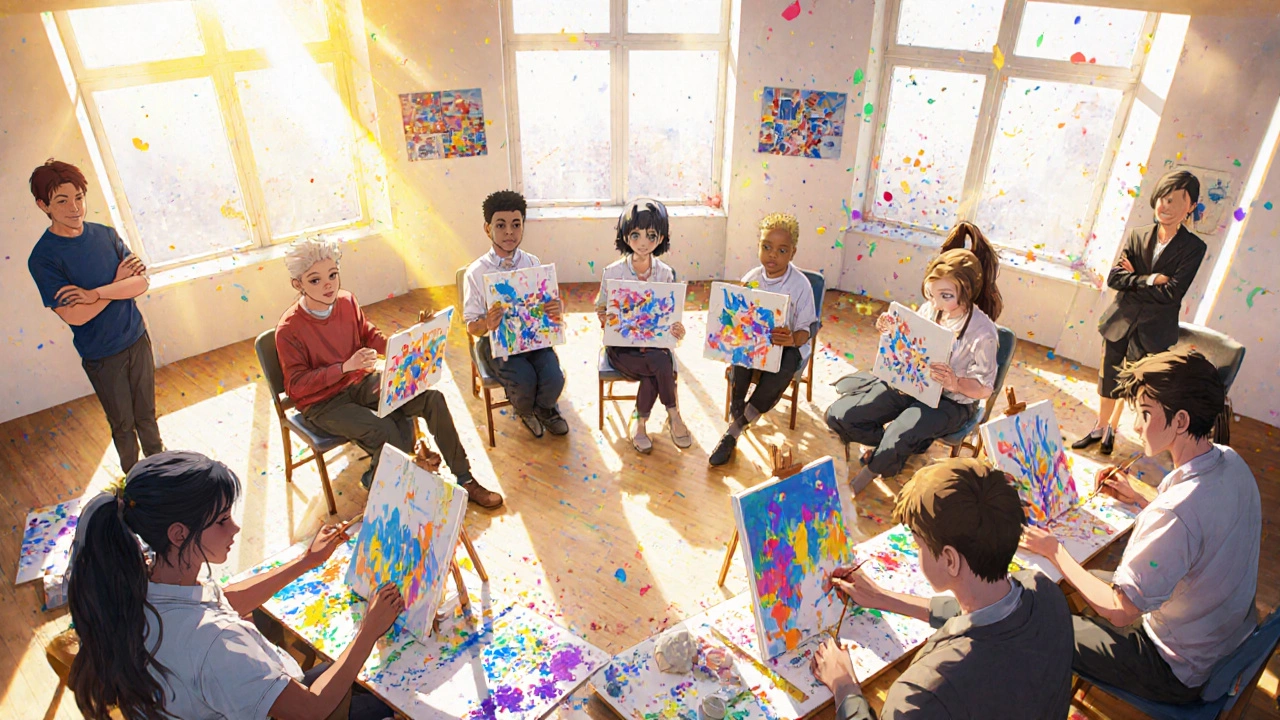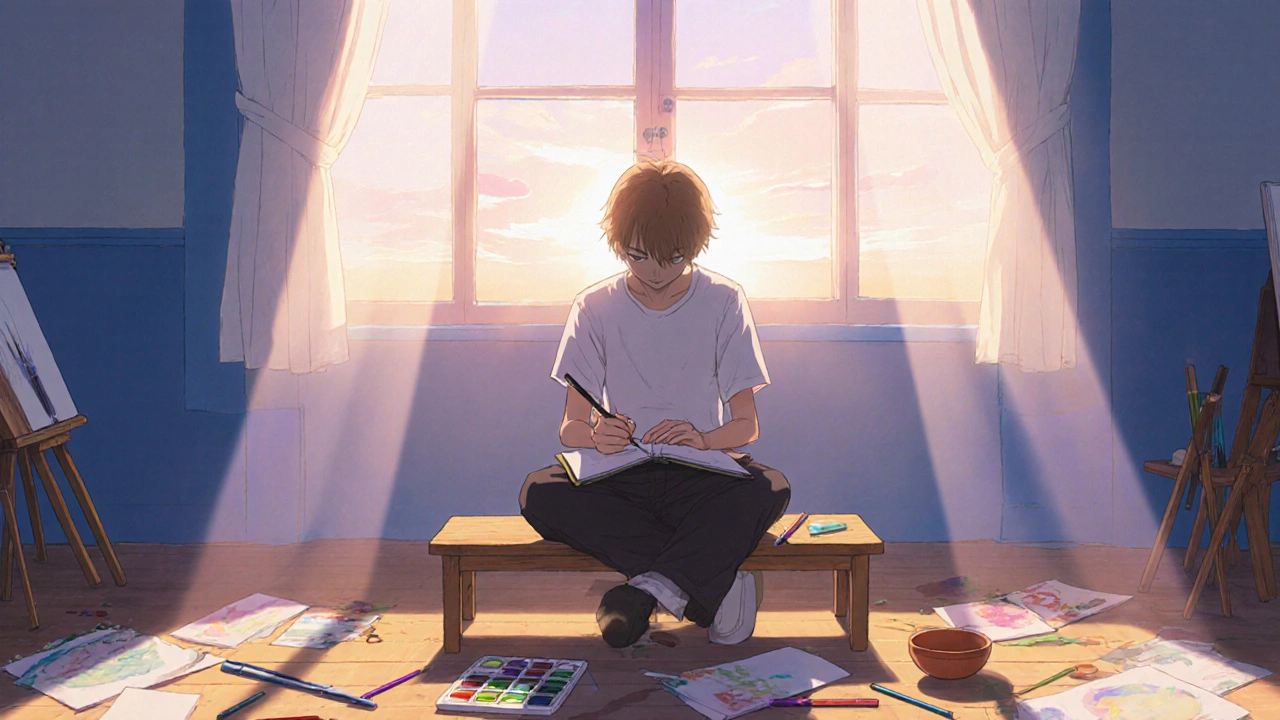PTSD Treatment Comparison Tool
Choose Your Treatment Options
Select one or more treatment methods to compare their key characteristics for PTSD management.
Creative expression to process trauma
Thought restructuring and exposure
Neurochemical modulation
Treatment Comparison Results
Key Differences
Primary Mechanism
How the treatment works at a fundamental level
Creative expression & neuro-plastic change
Thought restructuring & exposure
Neurochemical modulation
Typical Duration
Average time commitment for meaningful results
8-12 weeks (group) or ongoing
12-20 weeks (individual)
Months to years, continuous
Side Effects
Potential negative impacts of treatment
Minimal; occasional emotional overwhelm
Temporary anxiety during exposure
Weight gain, sexual dysfunction, insomnia
Evidence Strength
Research-backed effectiveness
Moderate to strong (effect sizes 0.5-0.7)
Strong (gold-standard)
Strong for symptom reduction
Best For
Who might benefit most from this approach
Clients who struggle with verbal articulation
Those who can engage in cognitive work
Severe acute symptoms needing rapid relief
Combined Approach Effectiveness
Using multiple treatments together may enhance outcomes
Important Note: Most clinicians recommend a blended approach. Art therapy complements traditional treatments like CBT and medication. Always consult with a licensed mental health professional to determine the best treatment plan for your specific needs.
When the mind is haunted by trauma, Art Therapy is a therapeutic approach that uses creative processes-drawing, painting, sculpting, or collage-to help individuals explore emotions and rebuild a sense of control. Expressive Arts Therapy has grown from a niche practice to a widely accepted complement to traditional mental‑health care.
Meanwhile, Posttraumatic Stress Disorder (PTSD) is a mental‑health condition triggered by experiencing or witnessing a terrifying event, leading to intrusive memories, hyperarousal, avoidance, and negative mood changes. In the United States, roughly 8% of the population will develop PTSD at some point, and many of those struggle to find relief through medication or talk therapy alone.
Understanding PTSD: Brain, Body, and Behavior
PTSD hijacks the brain’s threat detection network. The Amygdala acts as an alarm system, staying on high alert even when there is no real danger
At the same time, the prefrontal cortex-responsible for reasoning and emotional regulation-loses its ability to suppress the amygdala’s over‑reactivity. This imbalance spikes Stress Hormones like cortisol and adrenaline, which keep the body in a fight‑or‑flight state for hours, days, or even years.
Typical symptoms include flashbacks, nightmares, hypervigilance, and emotional numbing. These can lead to withdrawal, substance misuse, and physical health problems such as hypertension and chronic pain.
What Is Art Therapy?
Rooted in the work of psychiatrist Adrian Hill who coined the term during World War II to help bomb‑site survivors cope, art therapy blends psychology with the creative process. It is not about producing a masterpiece; it is about using the act of creating to access feelings that words cannot reach.
Therapists may guide clients through structured activities-like drawing a safe place-or allow free‑form expression with paint, clay, or digital media. The therapist observes choices of color, line, and composition, then helps the client reflect on what those choices reveal about inner states.
How Art Therapy Helps the PTSD Brain
Creative work stimulates Neuroplasticity the brain’s ability to rewire neural pathways. When a person engages in art, the brain’s visual‑spatial and motor networks light up, creating new connections that can compete with trauma‑related pathways.
At the same time, the rhythmic, focused nature of drawing or sculpting mimics Mindfulness practice, pulling attention away from intrusive memories and into the present moment. This reduces amygdala hyperactivity and lowers cortisol levels, offering measurable physiological relief.
Art also externalizes internal chaos. By putting a flashback onto a canvas, the client gains a sense of distance-a crucial step toward processing, rather than reliving, the trauma.
Evidence‑Based Benefits of Art Therapy for PTSD
Several studies underscore the effectiveness of art therapy. A 2023 randomized controlled trial involving 120 U.S. veterans found that participants who received 12 weeks of group art therapy showed a 30% reduction in PTSD symptom severity compared to a wait‑list control. MRI scans revealed decreased amygdala activation and increased prefrontal‑cortical thickness.
Another meta‑analysis of 22 trials (total N=1,730) reported an average effect size (Cohen’s d) of 0.68 for art therapy on anxiety, depression, and PTSD symptoms-comparable to standard cognitive‑behavioral interventions.
Beyond symptom reduction, art therapy improves quality of life, fosters social connection, and boosts self‑esteem. These outcomes matter because PTSD often isolates sufferers from friends, family, and work.
Integrating Art Therapy with Traditional Treatments
Most clinicians recommend a blended approach. Cognitive Behavioral Therapy (CBT) remains the gold‑standard for PTSD, focusing on restructuring trauma‑related thoughts. Art therapy adds a non‑verbal channel that can reach parts of the mind CBT alone may miss.
In practice, a patient might attend weekly CBT sessions, take a prescribed SSRI, and join a twice‑monthly art‑therapy group. The therapist collaborates with the psychiatrist to monitor progress, ensuring that creative work does not trigger overwhelming flashbacks without proper support.
Insurance coverage for art therapy varies, but many plans now list it under “psychological services” when provided by a certified art therapist. Checking with an Psychiatrist or licensed mental‑health provider can clarify eligibility.

Practical Tips: Getting Started with Art Therapy
- Find a qualified therapist: Look for credentials such as a Master’s in Art Therapy (M.A.T.) and state licensure. Websites of the American Art Therapy Association (AATA) list accredited professionals.
- Start simple: Use basic supplies-paper, colored pencils, watercolors-rather than expensive equipment.
- Set intentions: Before a session, think about what you hope to explore (e.g., “I want to draw my safe place”).
- Allow messiness: There is no right or wrong outcome. The process, not the product, is therapeutic.
- Debrief: After creating, discuss feelings with your therapist or a trusted friend.
Common Misconceptions
It’s not “just doodling.” While it may look casual, the therapeutic framing and guided reflection make it a structured intervention.
“You need artistic talent.” False. Research shows that individuals with no prior art experience benefit equally, because the value lies in expression, not skill.
“Art therapy replaces medication.” It’s a complement, not a substitute. Some people can taper meds under medical supervision after substantial progress, but decisions must be clinician‑led.
Quick Comparison: Art Therapy vs. CBT vs. Medication
| Aspect | Art Therapy | Cognitive Behavioral Therapy | Medication (e.g., SSRIs) |
|---|---|---|---|
| Primary Mechanism | Creative expression & neuro‑plastic change | Thought restructuring & exposure | Neurochemical modulation |
| Typical Duration | 8‑12 weeks (group) or ongoing | 12‑20 weeks (individual) | Months to years, continuous |
| Side Effects | Minimal; occasional emotional overwhelm | Temporary anxiety during exposure | Weight gain, sexual dysfunction, insomnia |
| Evidence Strength | Moderate to strong (effect sizes 0.5‑0.7) | Strong (gold‑standard) | Strong for symptom reduction |
| Best For | Clients who struggle with verbal articulation | Those who can engage in cognitive work | Severe acute symptoms needing rapid relief |
Next Steps and Troubleshooting
If you start art therapy and feel stuck, consider these adjustments:
- Switch medium: If paint feels intimidating, try collage or digital drawing.
- Adjust session length: Shorter 30‑minute sessions can reduce overwhelm.
- Coordinate with your therapist: Share any spikes in flashbacks so they can offer grounding techniques.
- Combine with mindfulness breathing before and after the creative work.
Remember, progress is not linear. Some weeks you may feel a surge of emotion; others you’ll notice subtle shifts in mood. Consistency, safety, and professional support are key.

Can art therapy replace traditional talk therapy for PTSD?
Art therapy is most effective when used alongside evidence‑based treatments like CBT or medication. It adds a non‑verbal outlet, but it does not address all cognitive distortions that talk therapy targets.
How long does it usually take to see improvement?
Most studies show noticeable symptom reduction after 8‑12 weekly sessions, though some clients report benefits sooner when they engage in regular self‑guided art practice.
Is art therapy covered by health insurance?
Coverage varies by provider and state. Many insurers list it under mental‑health services if delivered by a licensed art therapist. Always verify with your plan’s benefits department.
Do I need any artistic skill to start?
No. The therapeutic value lies in the process of creating, not the quality of the end product. Therapists are trained to work with complete beginners.
What if I become overwhelmed during a session?
A qualified art therapist will have grounding techniques ready-deep breathing, safe‑place visualizations, or brief pauses. It’s essential to communicate any distress promptly.

Brandy Eichberger
October 21, 2025 AT 13:36